As online experience became increasingly more of an everyday discussion in digital marketing it was expected that the fusion of User Experience (UX) and Search Engine Optimization (SEO) will emerge as a cornerstone of successful online strategies. This article analyses the symbiotic relationship between UX and SEO, unraveling how the seamless integration of user-centric design with astute search optimization practices can help your website rank higher in Google’s rankings, providing that Search Engine Result Page (SERP) boost. As we navigate through the intricacies of UX signals, or user experience criteria, if you will, and their profound impact on SEO, we invite you to uncover the art and science behind creating digital experiences that not only captivate and engage but as we will discuss can also significantly enhance your website’s visibility in the search engine result pages.
The Importance of UX for SEO
While SEO aims to boost a site’s visibility and rank position on the search engines, UX is all about ensuring visitors have a smooth and enjoyable interaction with your website. Meaning that they satisfied their intent by visiting your landing pages. This intersection is key because search engines, especially Google, now value user-centric metrics when determining rankings. Websites that deliver intuitive navigation, seamless cross-device usage, quick load times, with compelling, relevant, and helpful content not only keep visitors engaged but also signal to search engines that they’re valuable, credible and relevant sources of information, bringing positive impact on rankings.
What is UX?
User Experience (UX) is the feeling a user gets from interacting with a digital property, like a website or an app. It’s the sum of factors like ease of use, accessibility, intuitiveness, and the joy of completing tasks efficiently that affect the user’s opinion. Great UX design is all about putting the user first, ensuring their needs are met and their interaction with the product is positive, thereby fostering brand recognition and loyalty. Achieving great UX requires a deep dive into understanding the user profiles, their needs, their challenges, preferences, and the scenarios in which they use your product.
What are UX Signals?
UX signals, also known as “user interaction signals” or “user experience signals”, are crucial metrics used by search engines to assess whether a website effectively satisfies user needs. These signals are indicators of content quality, web design, site architecture, content format, and more. They reflect various aspects of user engagement and behavior, such as page dwell time, bounce rate, and click-through rate. Understanding and optimizing these signals can significantly enhance a site’s search engine rankings by demonstrating its value and relevance to visitors.
What is SEO?
Search Engine Optimization (SEO) is the sum of actions targeting at increasing organic traffic and attracting more relevant visitors to your website through organic search engine results. It involves a multifaceted strategy that tries to make your website more attractive to search engines. Things like optimizing for relevant keywords, creating quality content, building links, and ensuring your site is technically sound for crawling and indexing. Effective SEO is vital for digital visibility, driving more visitors, and potentially more business to your site.
The relationship between UX and SEO
UX and SEO’s relationship, has become crucial for the thriving of online platforms. Search engines strive to deliver the most relevant and quality content to their users. To this end, they evaluate websites not only based on the content and keywords but also on user engagement metrics such as time spent on a page, bounce rates, click-through rates and more. All these are indicators of the UX quality of the platform. Websites designed with a keen eye on UX naturally encourage users to stay longer and interact more, sending positive signals to search engines.
With the advent of Google’s Core Web Vitals, elements of user experience (UX) like loading time, interactivity, and visual stability have become direct factors influencing search rankings. This shift highlights the increasing importance of weaving UX principles and best practices into SEO strategies. By improving user experience, websites do not just aim at improving for their audience’s preferences but also at elevating their position in search rankings, creating a virtuous cycle that benefits both users and site owners.
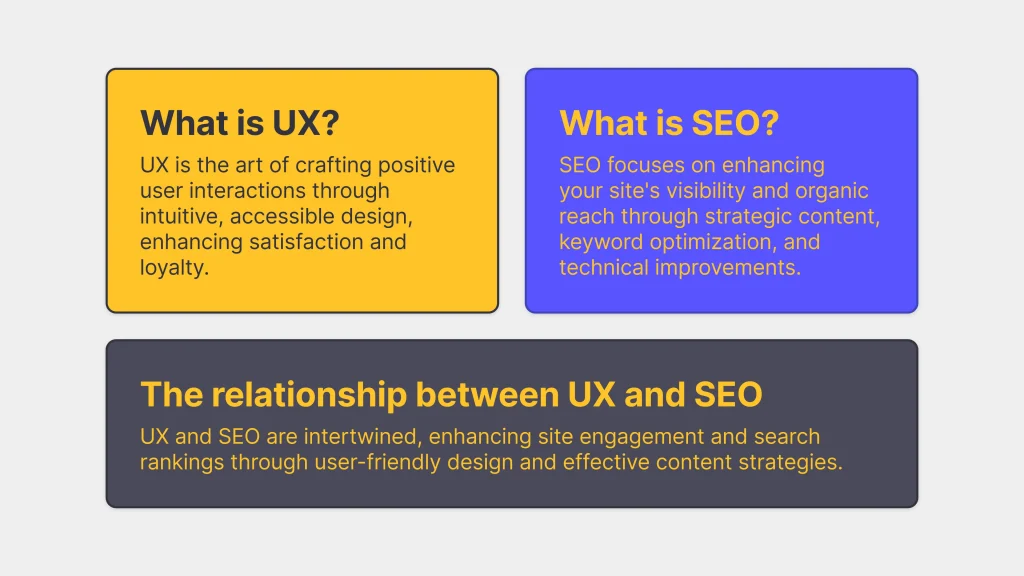
Understanding Core Web Vitals
The introduction of Core Web Vitals by Google, culminating in the June 2021 algorithm update, signified a paradigm shift in website evaluation and ranking, prioritizing user experience as a key determinant. This initiative underscores the importance of user experience elements, bringing them to the forefront of SEO strategies. As we dive deeper, we’ll explore what Core Web Vitals are, their impact on user experience, and their influence on SEO rankings, providing a comprehensive understanding of why they’re essential for any website looking to excel in the digital age.
What are Core Web Vitals?
Core Web Vitals are a set of specific factors that Google considers important in a webpage’s overall user experience. They are part of Google’s Web Vitals initiative, designed to provide unified guidance for quality signals that are essential to delivering a great user experience on the web.
The three pillars of Core Web Vitals are:
Largest Contentful Paint (LCP): Measures loading performance. To provide a good user experience, LCP should occur within 2.5 seconds of when the page first starts loading.
First Input Delay (FID): Measures interactivity. Pages should have an FID of 100 milliseconds or less to ensure interactions feel fluid.
Cumulative Layout Shift (CLS): Measures visual stability. To ensure a good user experience, pages should maintain a CLS of 0.1. or less.
How Core Web Vitals impact user experience
Core Web Vitals are fundamentally about improving the user experience on the web. A fast LCP ensures that the page is useful to users quickly, FID ensures it is interactive and responsive, and a low CLS ensures that the page is stable as it loads, preventing frustrating shifts that might cause accidental clicks or reading disruptions. By focusing on these aspects, websites can provide a smoother, more engaging experience that keeps users happy and engaged, reducing bounce rates and encouraging longer visit durations.
How Core Web Vitals influence SEO rankings
Websites that excel in the Web Vitals area are likely to see improvements in their search rankings, as Google aims to reward sites that offer superior user experiences. This move highlights the need for SEO professionals and website owners to optimize their sites beyond traditional SEO tactics, focusing on technical and design elements that enhance the overall user experience. In essence, by improving your site’s Core Web Vitals, you’re not only making your site more user-friendly but also boosting its potential to rank higher in search results, creating a win-win situation for both site owners and their visitors.
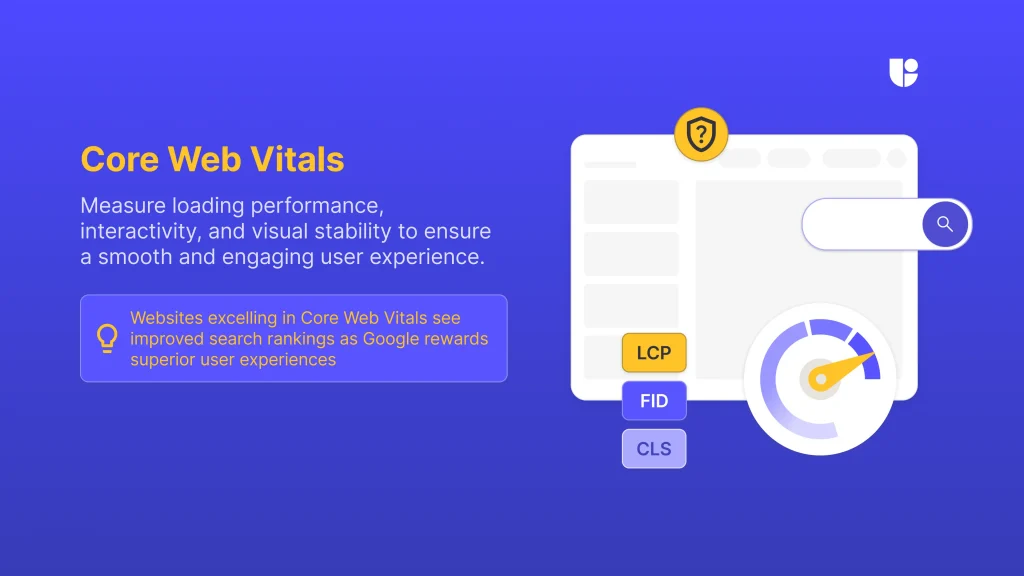
Key UX Metrics for SEO
In the online environment, particular UX metrics significantly impact SEO, acting as crucial indicators of user engagement and website performance. These measurements provide valuable insights into the way users engage with a website, offering concrete data that can be used to improve user experience and search engine rankings. We will examine four important UX metrics: dwell time, bounce rate, conversion rate, and task completion rate, all of which help improve an engaging and SEO-friendly website.
Dwell time: A measure of user engagement
Dwell time is the duration a visitor spends on your page before returning to the SERPs. This metric is a good indicator of landing page content, to search query relevance and user-to-landing page engagement. Extended dwell times are often interpreted by search engines as a sign of valuable content, positively influencing your site’s SEO. Enhancing content quality, providing clear navigation, and ensuring your pages load quickly can significantly increase dwell time, signaling to search engines that your site deserves a higher ranking.
Bounce rate: Understanding and reducing bounce rates
Bounce rate represents the percentage of visitors who land on your site and leave without interacting further. A high bounce rate can be a red flag to search engines, suggesting that your content might not be relevant or engaging enough for your audience. Improving this metric involves refining your content to match user intent, optimizing page load speeds, and ensuring your website is intuitively navigable. By addressing these aspects, you not only lower your bounce rate but also enhance the overall user experience, contributing to better SEO outcomes.
A small trick to help you reduce bounce rate is the incorporation of a small on-page action demand by the user like a click, or a scroll. This is especially important for websites where the visitor can quickly and easily consume information.
Conversion rate: The impact of UX on conversions
Conversion rate is the percentage of visitors who take a desired action on your site, such as making a purchase, signing up for a newsletter, or filling out a contact form. This metric is directly tied to how effectively your website’s UX guides users towards completing these actions. A user-friendly design, clear calls-to-action (CTAs), and a seamless navigation experience can dramatically improve conversion rates. While not a direct ranking factor, higher conversion rates indicate a successful UX, which indirectly benefits SEO by increasing user satisfaction and engagement.
Task completion rate: Ensuring users can accomplish their goals
Task completion rate measures the success rate of users completing specific tasks on your website, such as finding information or completing a purchase. This metric is crucial for understanding how well your site facilitates user goals. Enhancing task completion involves streamlining processes, reducing unnecessary steps, and ensuring clarity in your website’s user interface. Improving this rate not only signifies a superior UX but can also lead to higher dwell times and conversion rates, further bolstering your SEO efforts.
By monitoring and optimizing these key UX metrics, you can create a more engaging, user-friendly website that not only satisfies your visitors but also ranks favorably in search engine results, establishing a solid foundation for sustained online success.
Simplifying Navigation: No Confusing Web Visitor Journey
A straightforward and predictable visitor journey is a critical component of UX design that directly benefits SEO by fostering an environment where users feel guided and supported throughout their entire website experience. A clear and intuitive web visitor journey is paramount in ensuring a positive user experience, significantly influencing both engagement and SEO. Confusing navigation can lead to frustration, increased bounce rates, smaller website engagement rates, and a lower task completion rate, negatively affecting your website’s SEO performance. Simplifying the user’s journey involves creating a logical flow from one piece of content to another, employing clear and descriptive navigation labels, and ensuring that key information is easily accessible within a few clicks. Of course, keep in mind that any extra steps that can be avoided should be removed. By eliminating confusion and streamlining the path users take to find information or complete actions, you enhance user satisfaction, and with it your conversion rate, thus the amount of visitors turned into customers or leads.
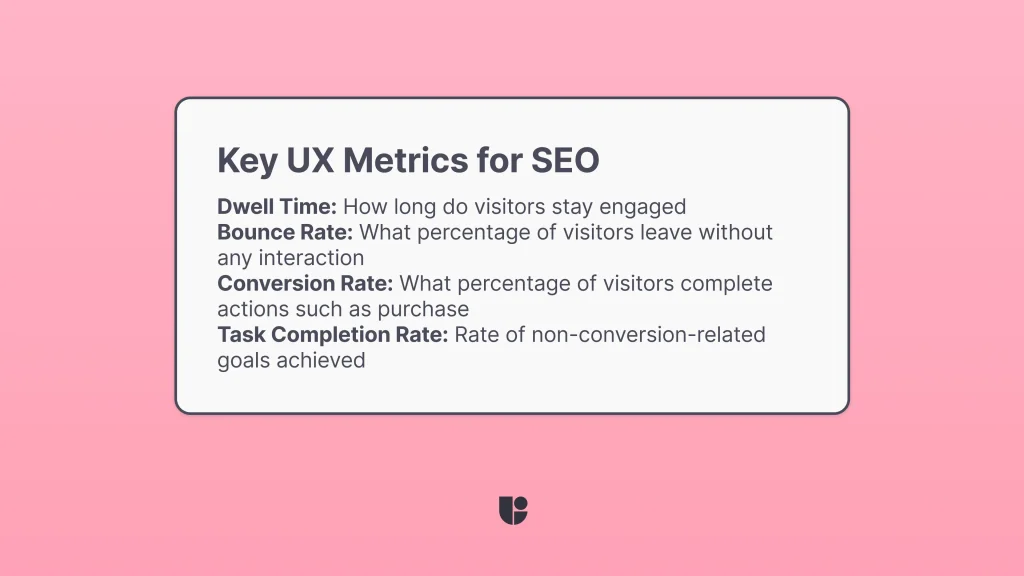
Optimizing Content for User Experience and SEO
In marketing, content is most often referred to as the king; it’s the main common ground between User Experience (UX) and Search Engine Optimization (SEO). Crafting content that resonates with both your audience and search engines is an art form that balances relevance, information, engagement, and discoverability. Let’s dive into how high-quality content plays a pivotal role in UX and SEO, the strategic incorporation of keywords, the critical nature of user satisfaction, and finding the sweet spot between content length and relevance for optimal SEO performance.
The role of high-quality content in UX and SEO
High-quality content serves a huge role for both a good user experience and a robust SEO strategy. It goes beyond containing information, it reaches providing value, solving problems, and engaging the audience in a meaningful way. For SEO, content quality affects not just rankings but also how users interact with your site. Engaging content keeps users on the page longer (increasing dwell time), encourages them to explore further (reducing bounce rates), and, most importantly, meets their needs and expectations, increasing conversion rates, all of which are positive signals to search engines.
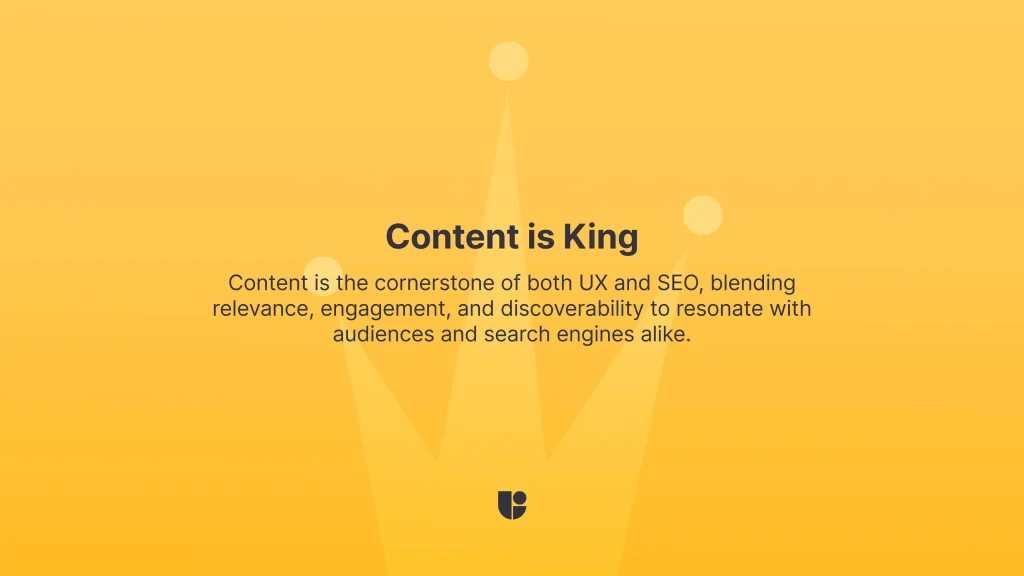
Incorporating relevant keywords for both users and search engines
Keywords are the bridge between user queries and your content. However, the key to successful keyword integration lies in its relevance and natural placement within your content. Gone are the days of keyword stuffing; today, it’s about ensuring that keywords enhance the content’s value, readability and answers user’s search query, while making it discoverable by search engines. Use keyword research to guide content creation but focus on topics and questions that your audience cares about, ensuring that keywords flow naturally within the context of valuable and informative content.
The importance of user satisfaction for SEO rankings
User satisfaction is a silent yet powerful driver of SEO success. Search engines, particularly Google, as we discussed earlier, are increasingly trying to interpret user satisfaction signals, such as page engagement metrics and interaction patterns. Content that meets and exceeds user expectations contributes to a positive user experience, leading to longer sessions, more page views, goal completions, and higher engagement—all favorable factors for SEO. Satisfying your audience’s informational or emotional needs with your relevant content can transform casual visitors into loyal followers, amplifying the positive signals sent to search engines.
Balancing content length and relevance for better SEO performance
The debate over the ideal content length for SEO is ongoing, yet the consensus leans towards relevance and depth over plain word count. The long-form content format has its place, especially for complex topics that demand comprehensive exploration and can result in increased dwell time and more backlinking opportunities. However, brevity paired with high relevance should not be underestimated, particularly for topics that can be effectively covered in fewer words. The balance lies in matching the content’s length to the user search intent and the topic’s complexity, ensuring every paragraph adds value and keeps the reader engaged. By focusing on creating content that is as long as necessary but as concise as possible, you cater to both user preferences and search engine algorithms, driving better SEO performance and user satisfaction.
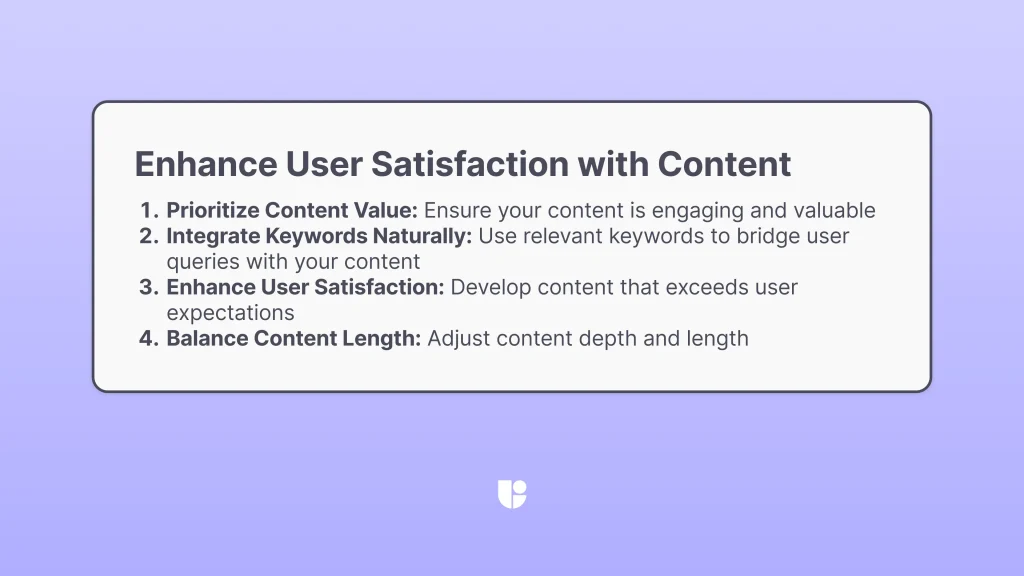
UI/UX Design and Its Impact on SEO
User Interface (UI) and User Experience (UX) design play a crucial role in shaping a website’s SEO success. Beyond aesthetics, effective UI/UX design ensures that a website is intuitive, accessible, and enjoyable for users, which, in turn, positively impacts SEO rankings. This segment explores the significance of user-friendly interfaces, the pivotal role of website structure and navigation, and the undeniable importance of responsive design and mobile optimization in the context of SEO.
Creating user-friendly interfaces for better SEO rankings
A user-friendly interface contains the visual elements, interactive features, and overall ease of use that contribute to a seamless interaction with a website. When users, and especially mobile users find a website easy to navigate and enjoyable to use, they’re more likely to stay longer, explore more pages, and engage with the content—behaviors that search engines interpret as indicators of quality and relevance. Consequently, websites with well-designed interfaces and proper internal links are often rewarded with higher SEO rankings, as they align with search engines’ goal to provide users with the best possible results to their search query.
The influence of website structure and navigation on user experience and SEO
The structure and navigation of a website are integral to both UX and SEO. A logical, well-organized website structure helps users find the information they need quickly and effortlessly, enhancing their overall experience. From an SEO perspective, a clear structure aids search engines in understanding and indexing the site’s content efficiently, which is crucial for visibility in search results. Furthermore, intuitive navigation minimizes user frustration and bounce rates, encouraging deeper interaction with the site and signaling to search engines that the site is valuable and deserving of a higher ranking.
Responsive design and mobile optimization for improved SEO performance
In today’s mobile-first world, responsive design and mobile optimization are non-negotiable for any website aiming for SEO success. Responsive design ensures that a website provides an optimal viewing experience across a wide range of devices, from desktops to smartphones, automatically adjusting layout and content to fit the user’s device. This adaptability not only improves the user experience but also favors search engine rankings, particularly since Google has adopted mobile-first indexing. Websites that are mobile-friendly rank better in search results, as they meet the needs of the majority of users who access the internet via mobile devices. By prioritizing responsive design and mobile optimization, websites can significantly enhance their SEO performance, reaching a wider audience and providing a superior user experience regardless of how or where the site is accessed.
UX Signals and User Behavior
Understanding and responding to UX signals and user behavior is becoming increasingly crucial for SEO success. As Google’s attention turned towards the overall user experience rather than just the plain content, mentions and more, it is now obvious that we need to invest more time in designing the envelope rather just the letter itself.
The insights provided by tools like Google Analytics, Microsoft Clarity and more can illuminate the path to a more engaging and optimized website. As UX signals, both humans and platforms interpret the user actions, the implications of bounce and retention rates on search rankings, and how leveraging these insights can boost SEO performance. But of course, those are always on already published content and pages.
This is where Useberry comes into play with the website usability feature that can get you real data fast on your web design and get your landing pages as optimized as possible with real user feedback. So get away from keyword stuffing and calling it SEO, run a UX research, and discover what positive ranking signals for SEO, mean for your website, based on what your audience needs are.
Understanding user behavior through Google Analytics data
Google Analytics serves as a powerful lens through which website owners can observe and analyze user behavior in granular detail. Though there is no experience metrics label, there are a lot of insights from the paths users take through your site to the time they spend on individual pages, this data provides a clear picture of what works and what doesn’t in your UX design. By examining metrics such as pageviews, session duration, and paths taken, you can identify content that resonates, uncover navigational challenges, and pinpoint opportunities for improvement. This level of understanding is crucial for making informed decisions that enhance both UX and SEO.
Analyzing user actions for insights into UX and SEO optimization
A deeper analysis into user actions, offers valuable clues for UX and SEO optimization. Actions like clicks, form submissions, and multimedia interactions can reveal user preferences and pain points. Analyzing these actions helps in refining the user journey, making content more accessible, and ensuring that CTAs are compelling and well-placed. This analysis not only improves user satisfaction but also signals to search engines that your website is engaging and relevant, potentially boosting your rankings.
How bounce rates and retention rates impact search rankings
Bounce rates and retention rates are critical metrics in understanding user engagement with your website and its impact on SEO. A high bounce rate might indicate that visitors aren’t finding what they’re looking for or that the user experience is lacking, prompting them to leave without significant interaction, getting search engines to believe that they did not find what they were searching for. On the other hand, a strong retention rate suggests that users find value in your content, compelling them to return. Search engines use these signals to gauge content relevance, with the respective search intent and quality, influencing your site’s search rankings. Lowering bounce rates and improving retention through enhanced UX can lead to better visibility in search results. Keep in mind that a greatly increased average time on your website can also become a negative user signal as it could signify that the user did not find the helpful content they were looking for and kept searching showcasing a poor user experience. Thus, you need to find just the right mix of time when it comes to the average session duration.
Leveraging user experience signals to improve SEO performance
Harnessing user experience signals to inform SEO strategies is a sophisticated approach to digital optimization. By aligning website improvements with user behavior insights, you can create a more engaging, user-friendly site that resonates with your audience and search engines alike.
Strategies may include optimizing page load times, enhancing content readability, improving navigational flow, and ensuring mobile responsiveness. Each improvement guided by user experience signals can contribute to higher engagement, lower bounce rates, and ultimately, superior SEO performance, crafting a digital environment where users and search engines find exactly what they’re looking for.
Navigational Disruptions and Their SEO Impact
In the journey to optimize a website for both users and search engines, understanding the nuances of session continuity becomes critical. One often overlooked aspect that can significantly disrupt this continuity is when users visit a page and swiftly navigate back, breaking the seamless flow of their experience. This action, seemingly simple, carries weighty implications for user engagement and, consequently, SEO rankings.
When users backtrack quickly from a page, it often signals a mismatch between their expectations and the content or experience provided. This behavior, known as “pogo-sticking,” can be indicative of several underlying issues, such as irrelevant content, poor page layout, slow loading times, or simply not meeting the user’s intent. From an SEO perspective, search engines may interpret this as a lack of content relevance or quality, potentially affecting the page’s standing in search results.
Addressing navigational disruptions
To resolve navigational disruptions you should conduct a deep dive into the user’s journey, identifying points where expectations diverge from reality. Solutions might include refining content to better align with target keywords, enhancing page load speeds, and ensuring that headings, meta descriptions, and titles accurately reflect the page’s content. Moreover, improving the overall navigational structure to offer users a clear path forward can significantly reduce the likelihood of session disruptions.
By mitigating factors that lead to navigational disruptions, websites can foster a more cohesive and satisfying user experience. This not only enhances user engagement and satisfaction but also sends positive signals to search engines, contributing to improved SEO performance. In essence, understanding and addressing the reasons behind users leaving pages prematurely can transform potential points of friction into opportunities for optimization, ultimately leading to a more seamless user journey and stronger search engine rankings.
Implementing User-Centric SEO Strategies
It has become evident that the most successful SEO strategies are those that place the user at their core. Implementing user-centric SEO strategies means going beyond traditional keyword optimization, internal linking, and backlinks; it involves a holistic approach that integrates user experience (UX) insights into every facet of your website’s design and content. At the heart of this approach is the incorporation of UX research into the product design process, a practice that bridges the gap between what users want and what search engines value.

Incorporating UX research into the product design process
The integration of UX research into product design is a fundamental step in crafting user-centric SEO strategies. This process begins with understanding your users’ behaviors, needs, and challenges through various research methods, such as user interviews, surveys, usability testing, and analytics review. This wealth of data provides a solid foundation for making informed decisions that enhance the user experience.
Armed with insights from UX research, designers and SEO specialists can work together to create a website that not only ranks well in search engines but also delivers a seamless and engaging user experience. Key considerations might include:
- Content Strategy: Developing content that addresses user questions, needs, and pain points, ensuring it is both informative and easily accessible.
- Site Architecture: Designing a website structure that reflects user expectations and behaviors, making it intuitive for users to navigate and find the information they seek.
- Interactive Elements: Ensuring that interactive elements like buttons, forms, and navigation menus are designed with usability in mind, facilitating smooth interactions that guide users towards their goals.
- Performance Optimization: Focusing on technical aspects like page load speed and mobile responsiveness, which are critical for both user satisfaction and search engine rankings.
By prioritizing user needs at every stage of the design process, you can create a website that not only meets but exceeds user expectations. This alignment between user satisfaction and SEO objectives leads to a virtuous cycle where improved user experiences drive better SEO outcomes, and higher search rankings bring more users to enjoy and engage with your site.
Incorporating UX research into product design is not a one-time task but an ongoing process of testing, learning, and iterating. As user behaviors and search engine algorithms evolve, so too must your strategies, ensuring that your website remains at the forefront of user-centric SEO practices. This dynamic approach guarantees that your website not only achieves high search rankings but also delivers real value to your users, fostering engagement, loyalty, and conversions.
How Useberry can help you optimize your website’s rankings
Utilizing UX research and the capabilities offered by Useberry for optimizing your UX user signals towards better results in Google Search result pages is the way forward.
The way you should start is by implementing interviews to clarify what your user intents, their needs, and the problems they currently face, are. This will help you understand what to test other than relevant content, and content formats and take your research towards ranking signals. To maximize your positive user interaction signals and respectively minimize if not eradicate the negative ones.
Then by setting up a 5-second test, you can check for the best structure, and page format that conveys the most information and guides the user most appropriately based on their search query. For that, you can use the Group and Randomize feature via which you can conduct A/B testing and set up your content with your dream page setup, or your current one, or even go a step further and input your competitor’s design.
Lastly, you should incorporate a usability test to maximize your positive user interaction signals as it would allow you to understand how to communicate your visible content so that the users understand the details provided and the next steps downward your marketing funnel and closer to the positive actions you declare as goals.
Other methods that Useberry offers that could be handy in the early design phase but also for your live websites are the Card Sorting and Tree Testing. With Card Sorting you can better understand how your customers logically group information together (explore users’ mental model of an information space) so that you can design your navigation or content (i.e. instructions, documentation, tutorials, demos, and other forms of user assistance.) accordingly. The Tree testing can help you evaluate existing navigation structures or navigation structures created after the card sorting ends.
To sum up, Useberry’s user testing feature can be set up to help you gain valuable insights into user behaviors, preferences, and pain points. By collecting real-time feedback, you can identify areas for improvement and make data-driven decisions to optimize your website’s UX.
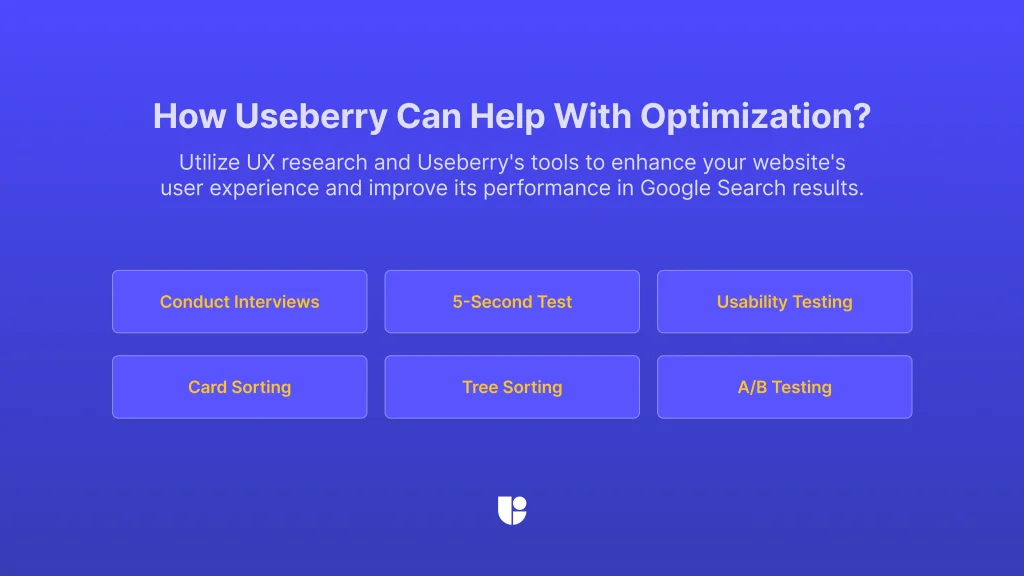
Conclusion
In conclusion, optimizing for UX signals, meaning your landing pages are delivering a stellar user experience is crucial for blending UX and SEO seamlessly, which is becoming imperative for achieving superior Google rankings. By embracing user-centric strategies and harnessing UX research tools like Useberry, websites can finely tune their interactions to align with user preferences and behaviors. This dual focus enhances performance for search engines and real users alike, boosting your online visibility, value, and appeal. These are key components for enduring success in a competitive digital landscape. Implementing these insights not only elevates your website’s SEO but also cultivates a loyal and satisfied user base, benefiting both site owners and their visitors. By understanding and applying these principles, you create a winning scenario where enhanced UX signals lead to improved search engine rankings and a thriving online presence.
Ready to take your website to the next level?
Sign up now and help your landing pages rank at the top of their potential!




